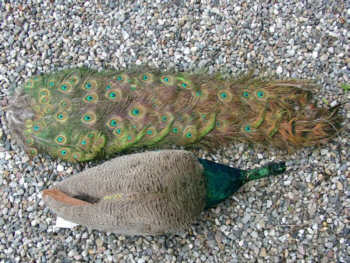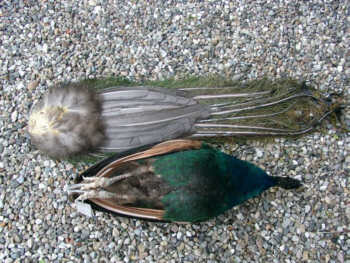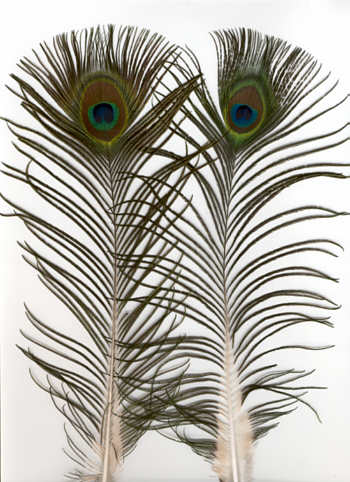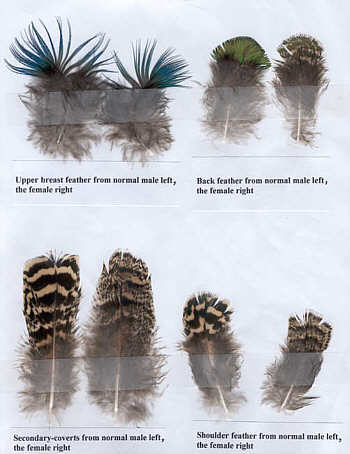CN 5628
Common Peafowl Pavo cristatus adult female, sex-reversal
19 Februar 2003, captivity, dead of obesity
The Peafowl was for 20 years in captivity by Harry Kaas, Søstbygade 3, DK-6230 Rødekro, Denmark. The first 18 years as a normal female with offspring every year, some of them white in spite of a normally mate. The last two years it changed to a male plumage with a 'tail' 1020mm long. It was fed on maize and pig food the last years.
Please click on images for larger size.
Photo 1
A dorsal view of the female Peafowl.
Photo 2
A ventral view of the female Peafowl.
Photo 3
One of the upper tail coverts from the female Peafowl and as comparison
also one from a normal male Peafowl with visible shorter 'eyespot'. Note,
there are minor differences both in form and colour of the 'eyespot'.
Photo 4
Feathers from different parts of the body, a normal male Peafowl left,
female Peafowl right.
Above left, breast feathers, above right, back feathers, below left, secondary-coverts,
below right shoulder feathers.
Complementary information:
Wing 415, bill 34.2, tail 457.0, tarsus 120.4, iris 11.5, eyeball 22.0,
ovary 25.5 x 10.1 with none visible testicular tissue, oviduct sinuous.
Weight ca. 3500g, very fat, food 88.460g included grit 57.854g, gizzard
75.016g, heart 9.373g, liver 41.888g, brain 5.959g, spleen 18.8 x 7.5,
0.524g
Concluding remarks:
'Ovarian medullary tissue normally becomes more active with age in females,
which in extreme cases overt masculinization in older females' (Gill 2003).
Sex reversal is a rare phenomenon, most often recorded in the pheasant
family Phasianidae (Brandt 1889, Zawadowsky & Zubina 1929, Harrison
1932, Buchanan & Parkes 1948,
Wennrich 1975, Yosidae et al. 1983, Crawford et al. 1987, Hagelin &
Kimball 1997). This can maybe be because many dimorphic galliform birds
should have estrogen-dependent plumage control in females and in case
of disease in the ovary or old age they therefore can change to partial
or full male plumage. This has been shown experimentally, by removing
the ovary the female developed male plumage (Hagelin & Kimball 1997).
In the actual case there was no visible disease in the ovary, (is kept
in alcohol).
Concerning the age 20 years should not be an especially old age. Acording
to Beebe (1990: vol. 4:184) the average age in the London Zoo was two
years among 66 specimens with maximum a little over eight years, but instances
are not uncommon of individual birds reaching an age of 40 or 50 years.
References:
Beebe, W. 1990: A Monograph of the Pheasants. Dover Publication, Mineola.
Brandt, A. 1889: Anatomisches und Allgemeines über die sogenannte Hahenfedrigkeit und über znderweitige Geschlechtsanomalien bei Vögeln. Z. f. wiss. Zool. 48: 151-190.
Buchanan, F. W. & K. C. Parkes. 1948: A female Bob-white in
male plumage. Wilson Bulletin 60: 119-120.
Crawford, J. A., P. J. Cole, & K. M. Kilbride. 1987: Atypical plumage of a female California Quail. Calif. Fish and Game 73: 245-247.
Gill, F. B. 2003: Ornithology. W. H. Freeman & Co., New York.
Hagelin, J. C. & R. T. Kimball. 1997: A female Gambel's Quail with partial male plumage. Wilson Bull. 109 (3): 544-546.
Harrison, J. M. 1932: A series of nineteen Pheasants (Phasianus colchicus L.) presenting anomalous secondary sexual characters in association with changes in the ovary. Proc. Zool. Soc. London 1932: 193-203.
Helgelbach, J. 1998: Hahnenfedriges Weibchen des Gartenrotschwanzes
Phoenicurus phoenicurus brütet erfolgreich. Ornithol. Beob. 95: 169-172.
Parrish, J. R., J. Stoddard, & C. M. White. 1987: Sexually mosaic plumage in a female American Kestrel. Condor 89: 911-913.
Riddle, O. 1924: A case of complete sex-reversal in the adult
pigeon. Amer. Nat. 58: 167-181.
Stoddard, H. L. 1921: Female Bay-breasted Warbler in male plumage.
Auk 38: 117.
Summers, S. G. & R. M. Kostecke. 2004: Female Brown-headed
Cowbird with partial male plumage. Wilson Bull. 116 (4): 293-294.
Wennrich, G. 1975: Zur Hahnenfedrigkeit einer chinesischen Zwergwachtel (Excalfactoria chinensis). J. Ornithol. 116 (2): 215.
Yosida, T. H., M. Y. Wada, Y. Sakal, & N. Kondo. 1983: Determination of the sex chromosome in a sex reversed peacock and its karyotype. Proc. Japan Acad. 59, Ser. B: 304- 307.
Zawadowsky, M. & E. Zubina. 1929: Hahnenfedrige Fasanenweibchen in Lichte der Embryogenese der Geschlechtsdrüsen. Arch. Entwicklungsmechanik des Organismen 115: 52-92.



